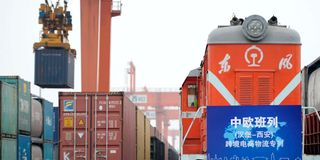China’s Pakistan trade corridor gives lessons on BRI challenge

A cross-border e-commerce freight train arriving in Xi'an, northwest China's Shaanxi Province. In Pakistan local communities have been raising their tempo of dissent giving China's mega transport BRI project builders a headache
China’s trade corridor in Pakistan is raising continual questions on violations of local communities’ rights, providing lessons to other countries like those in Africa on the challenge of the Belt and Road Initiative.
The China-Pakistan Economic Corridor (CPEC) is one of the biggest projects under the Belt and Road Initiative, China’s ambitious programme to tie down trade partners via linked roads, railways, ports and other infrastructure. It includes more than 140 countries including Kenya, Djibouti, South Africa and Egypt.
But in Pakistan, where the CPEC was said to be game changer for economic fortunes, local communities who feel left out of consultations have been raising their tempo of dissent, giving project builders a headache.
The Balochistan region, for example, one of the anchor areas of the project, has been raising protests for the CPEC, with local communities claiming they had been denied job opportunities while also claiming little environmental concerns for the region.
A local movement told rights watchdog the people in the area had been allocated only 5 percent of the jobs for projects in their area.
Launched in 2015, CPEC was seen as a corridor to boost Pakistan’s economic fortunes. It included loans, investments and other financial arrangements along a 2700 route from the Pakistani Arabian Sea port of Gwadar, in Balochistan province, to the Kashgar prefecture in China’s Xinjiang region.
Since 2015, however, the value of the project has climbed steadily, reaching $60 billion especially after Pakistan had to factor in security arrangements to guard against terror attacks on projects.
Overall, it could see new roads, railways, industrial zones and a new port set up.
Critics though pointed out that the CPEC has been opaque and faced with routine upheavals along the corridor, forcing the government to use force on opposition groups.
“CPEC could help revive Pakistan’s economy,” argued an analysis by the Crisis Group, which warned that without consultations, it could, however, …” deepen friction between the federal centre and periphery, roil provinces already long neglected, widen social divides and potentially create new sources of conflict.”
At least one percent of the value of the corridor has gone into security for Chinese workers, the group’s Group analysis observed.
With timelines for the project changed, owing to security and Covid-19, a recent paper also said the violations against community rights had been ignored.
Titled: ‘Construction of China-Pakistan Economic Corridor (CPEC) under the BRI Vision: Opportunities, Challenges and Countermeasures, the paper by the Centre for School of Anti-Terrorism of Northwest Politics and Law University, says the Chinese are also concerned about the security burden of the project, alongside the increased opposition to it.
The paper said the 5 percent representation in Balochistan, where the port will be erected, represent the lowest tap-ins for any strategic areas for a BRI project in Pakistan. The local ethnic community are about 4 million people.
The paper said this is in spite of the region being resource-rich. With fears about their future, local communities have taken up protests, violent responses and taking their cases to global rights bodies for reprieve, according to regional analysis platform Geo-politik.





